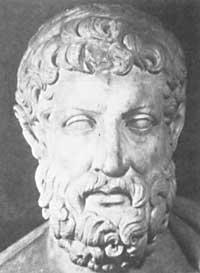The creation of science in Greece. Peripathetic, stoic and epicurea school

Aristotle's work was followed by his peripathetic students. Among them is the Theophrastus of Ereso. A. C. He was born in 372 and was a friend and follower of Aristotle. After the death of Aristotle he assumed the direction of the Lyceum. According to Laerzio, he wrote two hundred and sixty works on religion, politics, ethics, education, retolica, mathematics, astronomy, logic, meteorology, nature history. Unfortunately, we only have the pieces of them all. Among them, the most important are plants and stones.
About Botany he wrote two great works: "Historia plantis" and "De causis plantorum". The first one is completely descriptive and in it the different parts of the plants are distinguished and takes care of their difference. The second is more physiological and deals with the reproduction and growth of plants. Due to the large number of data that appear in these two books (especially the second), it is equal to those provided by Aristotle. It seems that to get this bunch of data (like Aristotle) he used a lot of friends, some of them were scientists traveling with Alejandro.
Also in mineralogy Theophrastus worked a lot and wrote "De lapidus". After analyzing rocks and minerals on this occasion, underlining their origin and use, he gave us many data. To classify them he wanted to use the method of fire, but with it he entered the world of chemistry. The best work of Theophrastus on mineralogy is the description of the precious stones. The morphological base is very large: it deals with color, brightness, hardness, etc.
Another student of Aristotle from the peripathetic school is Autoliko de Pitana. This, a. C. He was born in 360 and was especially concerned with the geometry of the sphere for astronomical and geographical purposes.
Another of the peripatetics to mention is the mesino Diseare. This is one of the founders of physical geography and has given us a description of the world drawn on a map. Along with this and as classmates, we have the Piteo of Masilia. This is the first known scientific navigator.
Finally, and to finish the news of the peripathetic school, we will quote the Straton of Lampsako. It is not known when he was born and when he died, but it seems that he went to. C. IV. He was born in the twentieth century and died in the third. However, most of his works are located in this last century. He participated with Theophrastus in the direction of the Lyceum, defending a totally mechanistic philosophy. But at this time Lizeo's school began to lose its importance.

Next to the peripathetic school was the stoic. The Zenón de Citio is considered the creator of the stoic school. He taught at a part of the Athens fair and in Greek the portico is "sto", so his school was called "estoico". These philosophers, based on Straton's ideas about natural forces, expanded their actions. They believe that the reason for all things is found in nature. Therefore, strength and matter can be complemented. According to this doctrine, the universe is indivisible and there is no essential division between matter and cause.
The science of the stoic school focused especially on cosmology. From a raw material, specifically the "pneum", the four elements follow. First fire, then soil, finally water and air. Ether is formed among all the universe. This school did not achieve anything special in the field of science, although from a philosophical point of view it had its importance.
To finish the classes next to Aristotle, we must mention the epicurea school. Its founder was Epicurus. A. C. Born in 342. In this school the atomist theory of Democritus is rethought. However, it caused a delay in the study of natural phenomena. The influence of this school has been especially philosophical, and if it appears in the history of science it is because it rethought the atomist theory of Democritus and Leucipo. Everything material and spiritual is made up of atoms, they said. These atoms can be seemingly different, they are everywhere and need not be united. In men, when they die, the atoms of the soul and body separate. Intelligence is also made up of atoms, but the atoms of the spirit are finer and distributed throughout the body. As we see, epicurism did not go down to natural phenomena and its work was limited only to the world of speculation.
It has often been implicitly said that science was not cultivated for the splendour of the fame of the philosophy of the classical Greek era, both of art and literature. But this is totally wrong. As we have seen, in this world science and scientific issues were of great importance. However, today we would say that the trend was more metaphysical than scientific. But at every age it must be given his own.





